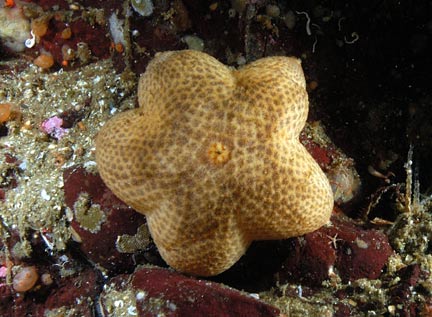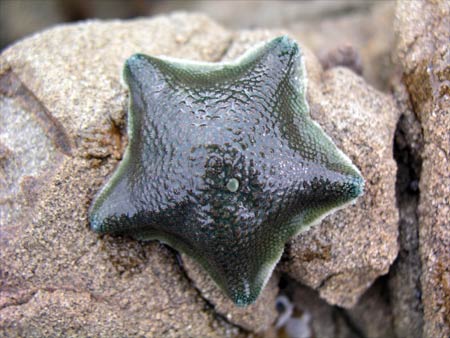
The cushion star falls into the phylum of Echinodermata. Some species in this class also include the brittle star and sea star. Some charecteristics of this class are radial symmetry, water vascular system, five arms, and two stomachs.
Common Name: Cushion Star
Scientific Name: Pteraster tesselatus
Phylum: Echinodermata
Family:Pterasteridae
Genus: Asteroidea
Species: Sea Star
Description: The cushion star is a thick-bodied species of starfish with short legs. It ranges in color from brown to orange, red, and yellow. They may be orange, brown, green, blue, purple or mottled combinations of these; their underside is pale pink. Usually they have five arms. Its hard shell is covered with raised knobby spines
Size: 0.4 inches-12 inches, worlds smallest sea star
Habitat: Sandy bottoms in the Atlantic waters from South Carolina to Florida. Inhabits rocky areas, tidal rock pools, coral reefs. Among sea stars, this species has the most restricted distribution. Currently found only within the coastal waters of southern Australia.
Diet: Opportunistic feeder, consuming essentially algal growth and detritus, although small epifaunal organisms and decaying animals are also eaten.
Physiological Features: Radial symmetery, which is the basic body plan in which the organism can be divided into similar halves by passing a plane at any angle along a central axis, They also contain a water vascular system, this is when system of closed, fluid-filled tubes and ducts of echinoderms used in clinging, locomotion, feeding, and respiration.
Reproductive Cycle: Unusual life-history. The cushion star is a hermaphrodite (self-fertilizing), has intragonadal fertilization, and incubates its young in the gonads(ovary). The strategy is to produce few eggs and small amounts of sperm at any one time. The advantage is a higher survival rate of offspring compared to the more usual strategy of broadcasting species.
